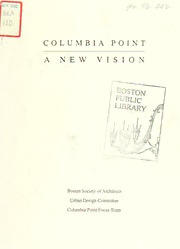
Columbia point, a new vision PDF
Preview Columbia point, a new vision
fn. ^0- 447-- COLUMBIA POINT NEW VISION A Boston Society ofArchitects Urban Design Committee Columbia Point Focus Team COLUMBIA POINT NEW VISION A Boston Society ofArchitects Urban Design Committee PUBLIC Columbia Point Focus Team Joan E. Goody. FAIA, Chair Kay Edward Alexander. AIA Ronald Bennett Michael M. Bernard Carmelo M. Garufo, AIA Anne C. Gelbspan Harvey Ray Montague, AIA Constance W. McMillin G. Michael Tzerai, AIA M0i»^-:-; ViV/ G t Ov.- \ M.i'^- *• COLUMBIA POINT NEW VISION A TABLE OF CONTENTS Introduction Executive Summary I Existing Conditions/CurrentDevelopment Activity II CriteriaforFuture Development/Urban Design Guidelines III Visions forthe Future INTRODUCTION Surrounded by water on three sides, with views of Boston Harbor and the Boston Skyline, Columbia Point is a superbly located peninsula with over two miles of shoreline,onlyminutesfromdountourn. Itisa likely location forthestrikingKennedy Library—building. Yet for much of its 20th century history it has been a dumping ground literally, for thecity's garbageand sewagepumping, and then forplaces no other neighborhood would accept: a prisoner of war camp in WWII, followed by the largest low-income housing project in New England, built shortly after that war. It is little wonder that the name, "Columbia Point" has had negative associations for many people northat those institutions which ventured out there to takeadvantageof the large amounts of available land were planned as isolated entities, insulated from their surroundings. Unfortunately this has led to a series of separate enclaves rather than a unified neighborhood and has limited the vision of what could be there. This report is a first step towards a new vision. Thecurrentcirculation and land usepatterns presenta remarkably disconnected setof roads with no coherent overall pattern. There is virtually no street system. A pedestrian has few and generally unpleasant paths, with dangerous crossings. Vehicularcirculation isequallyawkwarddueto the lackofcross-peninsulastreets,and the congestion caused by heavy through-traffic mixing with local traffic, along Morrissey Boulevard. These problems contribute to a lack of "sense of place" or neighborhood. TheBostonSocietyofArchitects FocusTeam was formed to lookat this largebutoften neglected part of ourcity and to stimulate thought about a vision to guide its growth and change. Its methods and objectives have been to: • Learn the current owners' goals for the future and their own development on the Point. Find areas of potential common, mutual benefit, and ways to achieve them; • Assess the uniqueresources ofthearea and consideralternatescenarios for its future; • Initiate a process that will involve the current owners, users and residents; Giveconsideration to theimpactsonadjacentareas; Recognizethepotential public resource the Point represents to the city and the region. • Stimulate thedevelopment ofa Masterplan to guide futuredevelopmenton Columbia Point. Over the last two years members of the Committee have had informal interviews (in person or on the phone) with representatives of all the major entities located on Columbia Point to learn more about the history and goals of these groups, their common problems and their ideas about wavs to improve conditions. FacingPage: mapofBoston identifyingColumbia Point,showingitslocation within the region and lUustrating its size by superimposing its shape on downtown Boston. Introduction Some of these institutions and theirdecision makers are among the most powerhil in the Commonwealth: the Un—iversity of Massachusetts, the Boston Globe, the Kennedy Library, theBankofBoston to namejusta few. MostcametoColumbia Point when theland was plentifulandcheapand wereattracted by the possibility ofbuildingtheir own"campus"orenclave. Astheycontinu—etoexistorexpandonColumbiaPointthese institutionsfacemanycommonproblems butforthemostparttheyhavebeentrying to solve them alone. Our work has revealed a number of areas where the chance for success could be greatly improved by concerted action. The following pages identify some of those goals and some critical steps that should be taken if they are to be achieved. And these steps must be taken promptly or the opportunity forColumbia Point to realize its potential will be lost. If each institution pursuesitsown goals without regard to its neighbors ora unified vision forthe future, that future will be severelv limited for all. Lacking a Masterplan orany vision to guide growth on Columbia Point as a whole in the years ahead, there is no basis for coordinating such changes. Plans by existing institutions forchangeorexpansion,as wellas newuses proposed forthearea,can not be evaluated in a useful context. Although millions of dollars of private and public money have been invested on Columbia Point in recent vears, and its character has changed significantly, it has not begun to reach its potential and is even in danger of dissipating those gains through lack of a coordinating concept. As development pressures increase in coming years, Columbia Point can expect further building. Now isthetime to guide thatdevelopment into theformation ofthe kind ofcommunityand neighborhood the residents and the citv want to see there. To highlight some of the opportunities that exist on Columbia Point and to encourage the development of a Masterplan that will maximize its potential we have written a report that : 1. Reviews the existing conditions 2. Establishes goals and criteria for future development 3. Suggests alternate scenarios for Columbia Point's future. This is notan exhaustivestudy; it is the beginningofan exploration that wehopewill be an inspiration for the kind of planning which can benefit this verv special part of Boston. Introduction
